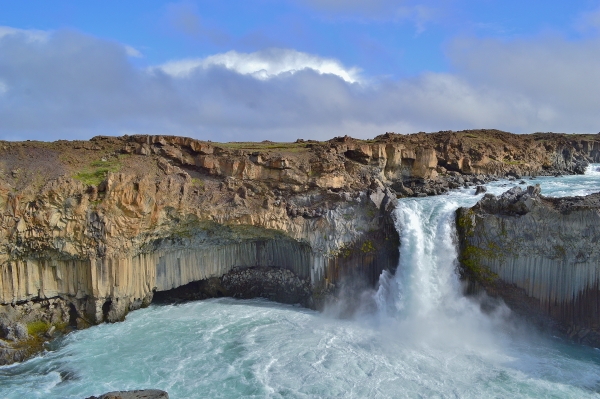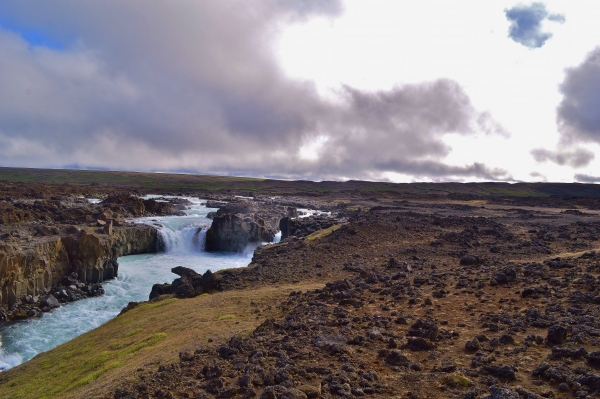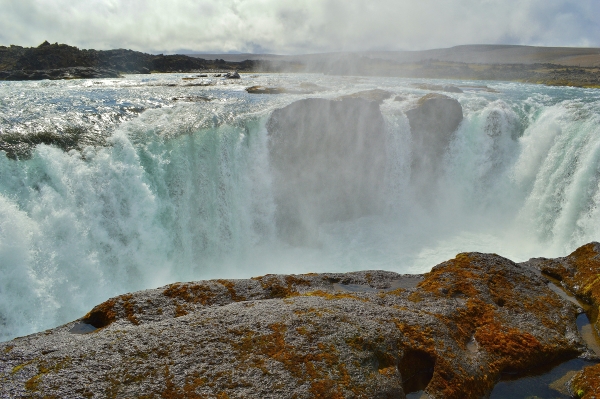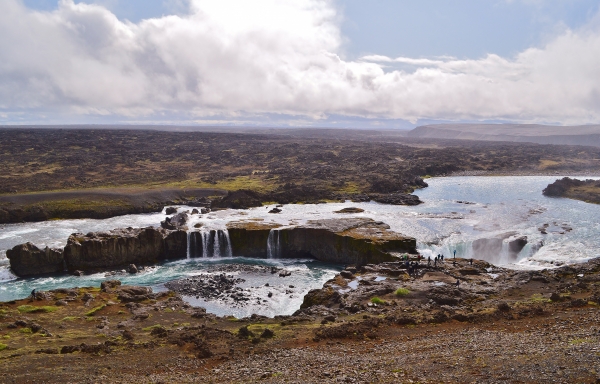Skjálfandafljót river is one of the most magnificent rivers in Iceland. Situated in North Iceland it has its source at the north-western edge of Vatnajökull glacier. Fed by meltwater from the glacier it flows south, parallel to the Sprengisandur mountain road (F26), emptying into Skjálfandi bay on the north coast. It is the fourth largest river in Iceland, measured by water flow. It is also home to some of the most spectacular waterfalls in Iceland.
Reaching these magnificent waterfalls is relatively easy. Aldeyjarfoss and Ingvararfoss can be reached by most vehicles. The short walk from the parking lot to Aldeyjarfoss takes you over rough terrain, and at this high elevation you can expect to encounter snow and ice late in spring. Hiking boots are a must and if you are visiting in spring or winter cleats might be necessary! Hrafnabjargafoss is located 2.5 km (1.5 mi) upstream. You can either drive along Sprengisandur route or hike along the river. The distance from the road to the waterfall is some 500 m (1,500 ft). Note that car rental companies require you to rent a 4×4 if you drive on a F-road. Violating this rule voids your rental car warranty.
A chain of spectacular waterfalls
The best known waterfall in Skjálfandafjót river is Goðafoss waterfall, just off the ring road. Goðafoss is one of the most powerful and beautiful waterfalls in Iceland, and one of the must-stops on the Ring Road. But while Goðafoss is one of the most popular tourist attractions in Iceland, visited by large crowds of travelers each year, fewer people visit the other spectacular waterfalls of Skjálfandifljót river. Just 40 km (25 miles) up the river is a chain of three waterfalls which are no less dramatic and magnificent than Goðafoss.

Aldeyjarfoss No less dramatic and picturesque than Goðafoss downstream. Photo/Steinar Kaldal
Aldeyjarfoss
Aldeyjarfoss is the best known of the three waterfalls. Aldeyjarfoss is within a short walking distance from the road to Sprengisandur. It was not very well known until the National Power Utility Landsvirkjun unveiled plans to build a dam on the Skjálfandifljót river. The dam would have destroyed Aldeyjarfoss, as well as its sisters upriver. By publicizing the waterfall and its beauty, conservationists were able to mobilize opposition to the plans. Thanks to public pressure the plans were dropped.
A welcome side-effect was that Aldeyjarfoss became a popular, off-the-beaten-path tourist destination.

Ingvararfoss Smaller than Aldeyjarfoss or Hrafnabjargafoss, Ingvararfoss is still a magnificent sight to behold. Photo/Steinar Kaldal.

Ingvararfoss Seen from the top of a nearby hill. Photo/Steinar Kaldal
Ingvararfoss
Aldeyjarfoss is only one of three sisters. Together the three waterfalls form a dramatic chain of three large waterfalls each within hiking distance from each other. The middle one is Ingvararfoss, just a short distance upriver from Aldeyjarfoss. Ingvararfoss is not marked on signposts, and few travellers are aware of the existence of this dramatic hidden waterfall, assuming Aldeyjarfoss is all there is to see. But if you hike a few hundred meters upriver from Aldeyjarfoss this majestic waterfall comes into view.

Hrafnabjargafoss The southernmost of the three is Hrafnabjargafoss, a spectacular fall which has everything which makes Icelandic waterfalls great. Photo/Steinar Kaldal.
Hrafnabjargafoss
Another hidden waterfalls, Hrafnabjargafoss is within hiking distance upstream from Ingvararfoss. Falling in two flows, on either side of a large rocky outcropping in the middle of the stream, it has all the features which make Icelandic waterfalls magical. Its eastern and northern part is composed of cascading rapids, and small streams which pour over the side of the island, while its western and southern part is a thundering waterfall which falls into a concentrated bowl, tunneling under a low stone arch before flowing back out into the river.

Hrafnabjargafoss The view from a nearby hill shows how Hrafnabjargafoss waterfall splits in two, falling on either side of a rocky island in the middle of the stream. Photo/Steinar Kaldal.
Skjálfandafljót river is one of the most magnificent rivers in Iceland. Situated in North Iceland it has its source at the north-western edge of Vatnajökull glacier. Fed by meltwater from the glacier it flows south, parallel to the Sprengisandur mountain road (F26), emptying into Skjálfandi bay on the north coast. It is the fourth largest river in Iceland, measured by water flow. It is also home to some of the most spectacular waterfalls in Iceland.
Reaching these magnificent waterfalls is relatively easy. Aldeyjarfoss and Ingvararfoss can be reached by most vehicles. The short walk from the parking lot to Aldeyjarfoss takes you over rough terrain, and at this high elevation you can expect to encounter snow and ice late in spring. Hiking boots are a must and if you are visiting in spring or winter cleats might be necessary! Hrafnabjargafoss is located 2.5 km (1.5 mi) upstream. You can either drive along Sprengisandur route or hike along the river. The distance from the road to the waterfall is some 500 m (1,500 ft). Note that car rental companies require you to rent a 4×4 if you drive on a F-road. Violating this rule voids your rental car warranty.
A chain of spectacular waterfalls
The best known waterfall in Skjálfandafjót river is Goðafoss waterfall, just off the ring road. Goðafoss is one of the most powerful and beautiful waterfalls in Iceland, and one of the must-stops on the Ring Road. But while Goðafoss is one of the most popular tourist attractions in Iceland, visited by large crowds of travelers each year, fewer people visit the other spectacular waterfalls of Skjálfandifljót river. Just 40 km (25 miles) up the river is a chain of three waterfalls which are no less dramatic and magnificent than Goðafoss.

Aldeyjarfoss No less dramatic and picturesque than Goðafoss downstream. Photo/Steinar Kaldal
Aldeyjarfoss
Aldeyjarfoss is the best known of the three waterfalls. Aldeyjarfoss is within a short walking distance from the road to Sprengisandur. It was not very well known until the National Power Utility Landsvirkjun unveiled plans to build a dam on the Skjálfandifljót river. The dam would have destroyed Aldeyjarfoss, as well as its sisters upriver. By publicizing the waterfall and its beauty, conservationists were able to mobilize opposition to the plans. Thanks to public pressure the plans were dropped.
A welcome side-effect was that Aldeyjarfoss became a popular, off-the-beaten-path tourist destination.

Ingvararfoss Smaller than Aldeyjarfoss or Hrafnabjargafoss, Ingvararfoss is still a magnificent sight to behold. Photo/Steinar Kaldal.

Ingvararfoss Seen from the top of a nearby hill. Photo/Steinar Kaldal
Ingvararfoss
Aldeyjarfoss is only one of three sisters. Together the three waterfalls form a dramatic chain of three large waterfalls each within hiking distance from each other. The middle one is Ingvararfoss, just a short distance upriver from Aldeyjarfoss. Ingvararfoss is not marked on signposts, and few travellers are aware of the existence of this dramatic hidden waterfall, assuming Aldeyjarfoss is all there is to see. But if you hike a few hundred meters upriver from Aldeyjarfoss this majestic waterfall comes into view.

Hrafnabjargafoss The southernmost of the three is Hrafnabjargafoss, a spectacular fall which has everything which makes Icelandic waterfalls great. Photo/Steinar Kaldal.
Hrafnabjargafoss
Another hidden waterfalls, Hrafnabjargafoss is within hiking distance upstream from Ingvararfoss. Falling in two flows, on either side of a large rocky outcropping in the middle of the stream, it has all the features which make Icelandic waterfalls magical. Its eastern and northern part is composed of cascading rapids, and small streams which pour over the side of the island, while its western and southern part is a thundering waterfall which falls into a concentrated bowl, tunneling under a low stone arch before flowing back out into the river.

Hrafnabjargafoss The view from a nearby hill shows how Hrafnabjargafoss waterfall splits in two, falling on either side of a rocky island in the middle of the stream. Photo/Steinar Kaldal.






